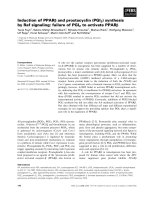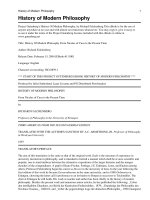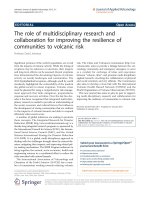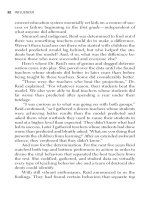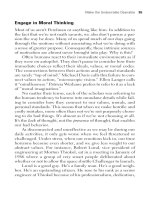Influencer of power to change anything_5 pot
Bạn đang xem bản rút gọn của tài liệu. Xem và tải ngay bản đầy đủ của tài liệu tại đây (730.02 KB, 21 trang )
116 INFLUENCER
In this and many similar studies, Mischel followed the chil-
dren into adulthood. He discovered that the ability to delay grat-
ification had a more profound effect than many had originally
predicted. Notwithstanding the fact that the researchers had
watched the kids for only a few minutes, what they learned from
the experiment was enormously telling. Children who had
been able to wait for that second marshmallow matured into
adults who were seen as more socially competent, self-assertive,
dependable, and capable of dealing with frustrations; and they
scored an average of 210 points higher on their SATs than peo-
ple who gulped down the one marshmallow. The predictive
power was truly remarkable.
Companion studies conducted over the next decade with
people of varying ages (including adults) confirmed that indi-
viduals who exercise self-control achieve better outcomes than
people who don’t. For example, if high schoolers are good at
self-control, they experience fewer eating and drinking prob-
lems. University students with more self-control earn better
grades, and married and working people have more fulfilling
relationships and better careers. And as you might suspect,
people who demonstrate low levels of self-control show higher
levels of aggression, delinquency, health problems, and so
forth.
Apparently, Mischel had stumbled onto the mother lode of
personality traits. Kids who had been blessed with the innate
capacity to withstand short-term temptations fared better
throughout their entire lives. The fact that a four-year-old’s one-
time response to a sugary confection predicts lifelong results is
at once exciting and depressing—depending on whether you
are a “grabber” or a “delayer.” You’re either well fitted to take
on the temptations of the world or doomed to a lifelong fate of
enjoy now, pay later—as might well be the lot of our friend
Henry.
But is this what’s really going on in these studies? Are some
people wired to succeed and others to fail?
Surpass Your Limits 117
One thing was clear from these studies: The ability to delay
gratification did predict a large number of long-term results.
That part of the marshmallow research nobody was arguing
about. However, for years scientists continued to debate the
cause of this strong effect. Did self-control stem from an
intractable personality characteristic or something more mal-
leable and thus learnable?
In 1965, Dr. Mischel collaborated on a study with Albert
Bandura who openly challenged the assumption that will was
a fixed trait. Always a student of human learning, Bandura
worked with Mischel to design an experiment to test the sta-
bility of subjects who had delayed gratification. In an experi-
ment similar to the marshmallow studies, the two scholars
observed fourth- and fifth-graders in similar circumstances.
They placed children who had not demonstrated that they
could delay gratification into contact with adult role models
who knew how to delay. The greedy kids observed adults who
put their heads down for a nap or who got up from the chair
and engaged in some distracting activity. The original “grab-
bers” saw techniques for delaying gratification. And to every-
one’s delight, they followed suit.
After a single exposure to an adult model, children who pre-
viously hadn’t delayed suddenly became stars at delaying. Even
more interesting, in follow-up studies conducted months later,
the children who had learned to delay retained much of what
they’d learned during the brief modeling session. So what
about those hardwired genetic characteristics or traits that had
predicted so much?
The answer to this important question is good news to all
of us and most certainly offers hope to Henry. When Mischel
took a closer look at individuals who routinely held out for
the greater reward, he concluded that delayers are simply
more skilled at avoiding short-term temptations. They didn’t
merely avoid the temptation; they employed specific, learnable
techniques that kept their attention off what would be merely
118 INFLUENCER
short-term gratification and on their long-term goal of earning
that second marshmallow.
So maybe Henry can learn how to delay gratification—if
he learns tactics that will help him do so. But will that be
enough to transform him into the physically fit person he’d like
to become? After all, he’s not good at jogging or weight lifting
either. In fact, he’s horrible at all things athletic. Surely factors
as hardwired as body type, lung capacity, and musculature are
predictors of good athletic performance. Henry has no hope of
ever becoming one of those chiseled hunks you see hanging
out at health clubs. Or does he?
MUCH OF PROWESS IS PRACTICE
Psychologist Anders Ericsson offers an interesting interpre-
tation of how those at the top of their game get there. He
doesn’t believe for a second that elite-level performance stems
from zodiacal forces or, for that matter, from enhanced men-
tal or physical properties. After devoting his academic life to
learning why some individuals are better at certain tasks than
others, Ericsson has been able to systematically demonstrate
that people who climb to the top of just about any field eclipse
their peers through something as basic as deliberate practice.
We’ve all heard the old saw that practice doesn’t make per-
fect, perfect practice makes perfect. Ericsson has spent his life
proving this to be true. While most people believe that they are
born with inherent limits to their athletic ability, Ericsson argues
that there is little evidence that people who achieve exceptional
performance ever get there through any means other than care-
fully guided practice—perfect practice. His research demon-
strates that prowess, excellence, elite status—call it what you
like—is not a matter of genetic gifts; it’s a matter of knowing how
to enhance your skills through deliberate practice.
For instance, Ericsson describes how dedicated figure
skaters practice differently on the ice: Olympic hopefuls work
Surpass Your Limits 119
on skills they have yet to master. Club skaters, in contrast, work
on skills they’ve already mastered. Amateurs tend to spend half
of their time at the rink chatting with friends and not practic-
ing at all. Put simply, skaters who spend the same number of
hours on the ice achieve very different results because they
practice in very different ways. In Ericsson’s research, this find-
ing has held true for every skill imaginable, including memo-
rizing complex lists, playing chess, excelling at the violin, and
conquering every extant sporting skill. It also applies to more
complex interactions such as giving speeches, getting along
with others, and holding emotional, sensitive, or high-stakes
conversations.
Before we move on, let’s take care to avoid a very large and
dangerous trap. The fact that improvements in performance
come through deliberate practice makes all the sense in the
world when it comes to activities such as figure skating, play-
ing chess, and mastering the violin. However, few people, if
any, would think of practicing with a coach to learn how to get
along with coworkers, motivate team members to improve
their quality measures, emotionally connect with a troubled
teen, or talk to a physician about a medical error. Most of us
don’t even think that soft and gushy interpersonal skills are
something you need to study at all, let alone something you’d
study and practice with a coach.
But that’s precisely what should be going on. Consider a
common problem at hospitals. A surgeon has just committed
a medical error. While performing a mastectomy, she’s acci-
dentally ripped a tiny muscle guarding the patient’s chest cav-
ity. The anesthesiologist sees a gauge jump, so it appears as if
one lung is no longer taking in air. Two of the nurses assisting
the operation see similar signs of distress. If the medical team
doesn’t start corrective action soon, the patient could die. But
before this happens, either the surgeon needs to take respon-
sibility or one of the other professionals needs to raise an
alarm.
120 INFLUENCER
Let’s focus on staff members who are assisting and predict
what they might do. Most would certainly hesitate for a few sec-
onds before suggesting that the surgeon has just made a mis-
take. They’ll hesitate because if they don’t handle the situation
well, they’ll come off as flippant or even insubordinate. There
are legal issues at play, and that only makes the discussion that
much more delicate. Worse still, they’ve seen colleagues
who’ve expressed a concern, turned out to be wrong, and then
received a tongue-lashing. Better to let someone else take the
risk. Precious seconds continue to pass.
This and tens of thousands of similar medical errors con-
tinue to happen because individuals who may have practiced
drawing blood or moving a patient or reading a gauge dozens
of times haven’t studied and practiced how to confront a col-
league—or even more frightening—a physician. They aren’t
exactly sure what to say and how to say it. They certainly lack
the confidence that comes from having practiced.
Of course, health care isn’t the only field in which a lack
of interpersonal know-how has caused serious problems. Every
time a boss expresses a half-baked, even dangerous, idea and
subordinates bite their tongues for fear of being chastised,
good ideas remain a secret and teams make bad decisions.
Speaking up to an authority figure requires skill, and skill
requires practice. The same is true for confronting a mentally
abusive spouse or dealing with a bully at school or—here’s a
hot one—just saying no to drugs. Try that without getting
ridiculed or beat up. Interpersonal interactions can be extra-
ordinarily complicated, and most will improve only after indi-
viduals receive instruction that includes deliberate practice.
Consider the problem Dr. Wiwat Rojanapithayakorn faced
when attempting to encourage young, poor, shy, female sex
workers to deny services to older, richer male customers if the
customers refused to use a condom. At first the young girls
mumbled their disapproval, only to be intimidated by their
vocal clients. Not knowing what to say or how to say it, they’d
Surpass Your Limits 121
quickly give in and put themselves and thousands of others
at risk.
Eventually Wiwat asked more seasoned sex workers to train
young girls on how to defend their health. They shared actual
scripts that helped them avoid offending the customer while at
the same time holding a firm line. Equally important, the
young women actually practiced the conversation until they
had gained confidence in what they were going to say and how
they would say it. They continued to practice and receive feed-
back until they had mastered their scripts well enough to actu-
ally use them at work. In this particular case, providing detailed
coaching and feedback helped compliance with the strict con-
dom code rise from 14 percent to 90 percent in just a few
years—saving millions of lives.
Many of the profound and persistent problems we face stem
more from a lack of skill (which in turn stems from a lack of
deliberate practice) than from a genetic curse, a lack of courage,
or a character flaw. Self-discipline, long viewed as a character
trait, and elite performance, similarly linked to genetic gifts,
stem from the ability to engage in guided practice of clearly
defined skills. Learn how to practice the right actions, and you
can master everything from withstanding the temptations of
chocolate to holding an awkward discussion with your boss.
PERFECT COMPLEX SKILLS
Let’s return to a point we made earlier. Not all practice is good
practice. That’s why many of the tasks we perform at work and
at home suffer from “arrested development.” With simple tasks
such as typing, driving, golf, and tennis, we reach our highest
level of proficiency after about 50 hours of practice; then our
performance skills become automated. We’re able to execute
them smoothly and with minimal effort, but further develop-
ment stops. We assume we’ve reached our highest performance
level and don’t think to learn new and better methods.
122 INFLUENCER
With some tasks, we stop short of our highest level of pro-
ficiency on purpose. The calculus we perform in our heads sug-
gests that the added effort it’ll take to find and learn something
new will probably yield a diminishing marginal return, so we
stop learning. For instance, we learn how to make use of a word
processor or Web server by mastering the most common moves,
but we never learn many of the additional features that would
dramatically improve our ability.
This same pattern of arresting our development applied
over an entire career yields fairly unsatisfactory results. For
example, most professionals progress until they reach an
“acceptable” level, and then they plateau. Software engineers,
for instance, usually reach their peak somewhere around five
years after entering the workforce. Beyond this level of medi-
ocrity, further improvements are not correlated to years of
work in the field.
So what does create improvement? According to Dr. Anders
Ericsson, improvement is related not just to practice, but to a
particular kind of practice—something Ericsson calls deliberate
practice. Ericsson has found that no matter the field of exper-
tise, when it comes to elite status, there is no correlation what-
soever between time in the profession and performance levels.
The implications are stunning. A 20-year-veteran brain
surgeon is not likely to be any more skilled than a 5-year rookie
by virtue of time on the job. Any difference between the two
would have nothing to do with experience and everything to
do with deliberate practice. Time is required (most elite per-
formers in fields such as music composition, dance, science,
fiction writing, chess, and basketball have put in 10 or more
years), but it is not the critical variable for mastery. The criti-
cal factor is using time wisely. It’s the skill of practice that makes
perfect.
Most of us already have all the evidence we need to con-
firm that deliberate practice can have an enormous effect on
performance levels. Just look at what’s happened to our capac-
Surpass Your Limits 123
ity to teach everything from mathematics to high jumping.
Roger Bacon once said that it would take a person 30 to 40
years to master calculus—the same calculus that is taught in
most high schools today. Today’s musicians routinely match
and even surpass the technical virtuosity of legendary musicians
of the past. And when it comes to sports, the records just keep
falling. For example, when Johnny Weissmuller of Tarzan
fame won his five Olympic gold medals in swimming in 1924,
nobody expected that years later high school kids would post
better times.
What, then, is deliberate practice? And how can we apply
the techniques to our vital behaviors and thus strengthen our
influence strategy?
Demand Full Attention for Brief Intervals
Deliberate practice requires complete attention. Deliberate
practice doesn’t allow for daydreaming, functioning on autopi-
lot, or only partially putting one’s mind into the routine. It
requires steely-eyed concentration as students watch exactly
what they’re doing, what is working, what isn’t, and why.
This ability to concentrate is often viewed by students as
their most difficult challenge, enough so that elite musicians
and athletes argue that maintaining their concentration is usu-
ally the limiting factor to deliberate practice. Most can main-
tain a heightened level of concentration for only an hour
straight, usually during the morning when their minds are
fresh. Across a wide range of disciplines, the total daily prac-
tice time of elite performers rarely exceeds five hours a day, and
this only if students take naps and sleep longer than normal.
Provide Immediate Feedback Against a Clear Standard
The number of hours one spends practicing a skill is far less
important than receiving clear and frequent feedback against
124 INFLUENCER
a known standard. For example, serious chess players spend
about four hours a day comparing their play to the published
play of the world’s best players. They make their best move, and
then compare it to the move the expert made. When their
move is different from the master’s, they pause to determine
what the expert saw and they missed. As a result of comparing
themselves to the best, students improve their skills much
faster than they would otherwise. This immediate feedback,
coupled with complete concentration, accelerates learning.
Players know quickly when they are off course, and they learn
from their own poor moves.
As you might imagine, sports stars require rapid feedback
to improve performance as well. They tend to focus on small
but vital aspects of their play and scrupulously compare one
round to the next. Swimming gold medalist Natalie Coughlin
completes each leg of her races with fewer strokes than her
opponents, giving her a tremendous advantage in stamina. Her
practice is focused on the minute details of each stroke. She
explains: “You’re constantly manipulating the water. The slight-
est change in pitch in your hand makes the biggest difference.”
At the conclusion of each lap, Natalie is acutely aware of the
number of strokes she took to complete it, and she adjusts her
hand position for the next lap. This kind of focused, deliber-
ate practice enhances performance more rapidly than does
merely swimming laps.
This concept of rapid feedback stands traditional teaching
methods on their heads. Many teachers believe that tests are
painful experiences that should be given as infrequently as pos-
sible so as not to discourage students. Research reveals that the
opposite is true. Ethna Reid taught us that one of the vital
behaviors for effective teachers is extremely short intervals
between teaching and testing. When testing comes frequently,
it becomes familiar. It’s no longer a dreaded, major event. It
provides the chance for people to see how well they’re doing
against the standard.
Surpass Your Limits 125
Think about how deliberate practice with clear feedback
compares with the way we currently train our leaders. Rarely
do business school and management faculties think of leader-
ship as a performance art. Faculty members typically teach
leaders how to think, not how to act. So when would-be exec-
utives take MBA courses or graduate executives attend leader-
ship training, they’re routinely asked to read cases, apply
algorithms, and the like, but there’s a good chance that they’ll
never be asked to practice anything.
Granted, business schools typically offer a course in giving
presentations and speeches where the performance compo-
nents that students are asked to practice are so obvious. But this
is not the case with other important leadership skills, such as
addressing controversial topics, confronting bad behavior,
building coalitions, running a meeting, disagreeing with
authority figures, or influencing behavior change—all of which
call for specific behaviors, and all of which can and must be
learned through deliberate practice.
Break Mastery into Mini Goals
Let’s add another dimension to deliberate practice. We start
with a test. How would you motivate patients to take pills that
one day might prevent them from experiencing a stroke? If
they’ve already had one stroke, you’d think it would be easy to
get them to take the lifesaving pills. But let’s add a confound-
ing factor. The pills often cause leg cramps, painful rashes, loss
of energy, constipation, headaches, and sexual dysfunction. So
patients take a pill, and they will most assuredly suffer short-
term results, but maybe they won’t have a stroke sometime way
out in the future. This is going to be a hard sell. In fact, for years
many stroke patients didn’t take their pills because they didn’t
like the odds.
This all changed when researchers stopped focusing on
long-term goals (avoiding another stroke) and created a regimen
126 INFLUENCER
that helped patients set mini goals and then provided rapid
feedback against them. Researchers gave patients packets of
pills, a blood pressure monitor, and a log book. Every day they
took the pills, monitored their blood pressure, and recorded
changes in the log book along with other achievements. The
change was dramatic and immediate. By setting small goals
(daily monitoring and recording) and meeting them, patients
now focused on something they could see and control. This
enhanced their sense of efficacy, clarified the effect of the med-
icine, and motivated compliance. Now these patients take
their pills.
Influence masters have long known the importance of set-
ting clear and achievable goals. First, they understand the impor-
tance of setting specific goals. People say that they understand
this concept, but few actually put the concept into practice. For
example, average volleyball players set goals to improve their
“concentration” (exactly what is that?), whereas top performers
decide they need to practice tossing the ball correctly—and they
understand each of the elements in the toss.
As part of this focus on specific levels of achievement, top
performers set their goals to improve behaviors or processes
rather than outcomes. For instance, top volleyball performers
set process goals aimed at the set, the dig, the block, and so on.
Mediocre performers set outcome goals such as winning so
many points or garnering applause. In basketball, players who
routinely hit 70 percent or more of their free throws tend to
practice differently from those who hit 55 percent or less.
How? Better shooters set technique-oriented goals such as,
“Keep the elbow in,” or, “Follow through.” Players who shoot
55 percent and under tend to think more about results-oriented
goals such as, “This time I’m going to make ten in a row.”
This difference in focus is also borne out when players blow
it. Researchers stopped players who missed two free throws in
a row and asked them to explain their failure. Master shooters
were able to cite the specific technique they got wrong. (“I
Surpass Your Limits 127
didn’t keep my elbow in.”) Poorer shooters offered vague expla-
nations such as, “I lost concentration.”
The role of mini goals in maintaining motivation also
deserves attention. With certain skills, people are deathly afraid
that they won’t succeed. And once they do fail, they fear that
bad things will happen to them. As you might imagine, when
people predict that their actions will lead to catastrophic results,
these failure stories lead to self-defeating behavior. Individuals
begin with the hypothesis that they will never succeed and that
the failure will be costly, and then they look for every shred of
proof that they’re about to fail so they can bail out early before
they suffer too much—which they do anyway.
When fear dominates people’s expectations, not only do
you have to improve their actual skill, but you have to take spe-
cial care to ensure that their expectations of success grow right
along with their actual ability. But how? As we learned earlier,
simply using verbal persuasion isn’t enough to convince them.
(“Go ahead, the snake won’t bite!”) For example, in one line
of research scholars learned that you can teach dating skills to
shy sophomores, but the students need to see proof of constant
progress before they’re willing to admit that they’ve learned any-
thing useful or before they put the new skills into practice.
And where do people find this proof of progress? From
progress itself. Nothing succeeds like success. As people suc-
ceed, they learn through personal experience (the real deal for
changing understanding, which can be a powerful tool for
changing minds) that they actually can achieve their goals.
Unfortunately, skeptical people aren’t likely to attempt behav-
iors that they perceive to be risky, so they never succeed. Now
what’s a person to do?
Dr. Bandura points out that to encourage people to attempt
something they fear, you must provide rapid positive feedback
that builds self-confidence. You achieve this by providing short-
term, specific, easy, and low-stakes goals that specify the exact
steps a person should take. Take complex tasks and make them
128 INFLUENCER
simple; long tasks and make them short; vague tasks and make
them specific; and high-stakes tasks and make them risk free.
If you want to see how to put short-term, specific, easy, low-
stakes goals into play on a much grander scale, take a look at
our friends at Delancey Street. The entering criminals and soci-
etal castoffs that Dr. Silbert works with are typically illiterate
and completely unskilled. Not only do they not have job
expertise or academic talent, but they also lack interpersonal
and social survival skills.
So what do you do when you have to teach residents
dozens or even hundreds of skills? You eat the elephant one
bite at a time. You select one domain, say a vocational skill such
as working in a restaurant, then choose a small skill in that area.
For example, on the very first night you teach the nervous new-
comer how to set a table—maybe just the forks. Then, this
novice who is very likely to be suffering from drug withdrawal
along with culture shock and other physical and emotional
problems practices placing the fork until he or she gets it right.
Next comes the knife.
Prepare for Setbacks; Build In Resilience
As important as it is to use baby steps to ensure short-term suc-
cess during the early phases of learning, if subjects experience
only successes early on, then failures can quickly discourage
them. A short history of easy successes can create a false expec-
tation that not much effort is required. Then if subjects run into
a problem, they become discouraged.
To deal with this problem, people need to learn that effort,
persistence, and resiliency are eventually rewarded with suc-
cess. Consequently, the practice regime should gradually intro-
duce tasks that require increased effort and persistence. As
learners overcome more difficult tasks and recover from inter-
mittent defeats, they see that setbacks aren’t permanent road-
blocks, but signals that they need to keep learning.
Surpass Your Limits 129
This capacity to tell ourselves the right story about problems
and setbacks is particularly important when we’re already bet-
ting against ourselves. When faced with a setback, we need to
learn to say, “Aha! I just discovered what doesn’t work,” and not,
“Oh no! Once again I’m an utter failure.” We need to inter-
pret setbacks as guides, and not as brakes.
Initially, failure signals the need for greater effort or persist-
ence. Sometimes failure signals the need to change strategies
or tactics. But failure should rarely signal that we’ll never be
able to succeed and drive us to pray for serenity. For instance,
you find yourself staring at a half-eaten ice cream cone in your
hand. Should you conclude that you’re unable to stick with
your eating plan so you might as well give up? Or should you
conclude that since it’s hard to resist when you walk past the
ice cream parlor on your way home from work, you should
change your route? The first conclusion serves as a discourag-
ing brake on performance, whereas the second provides a cor-
rective guide that helps refine your strategy.
BUILD EMOTIONAL SKILLS
Let’s end our exploration into self-mastery where we began.
Henry is staring down at his half-opened chocolate bar. His
eyes, lips, and taste buds are prodding his brain to satisfy their
demands. He wants chocolate. To see if Henry is doomed—or
if he can learn a skill to help him delay gratification—let’s turn
to research that helps us better understand the original marsh-
mallow study.
Contemporary research reveals that human beings operate
in two very different modalities, depending on the circum-
stances. However, as Mischel and Bandura informed us, these
modalities or systems are viewed less as character traits or
impulses and more as behaviors that can be regulated through
skill. The first of these two operating modalities is referred to
by contemporary theorists as our “hot” or “go” system. It helps
130 INFLUENCER
us survive. We stumble upon something threatening—say a
tiger—and as our “go” system takes over, our brain sends blood
to our arms and legs, our heart rate and blood pressure increase,
and, like it or not, we start producing cholesterol—just in case
we face blunt trauma.
More intriguing still, as our “go” system kicks in and blood
flows out of the brain and toward our arms and legs, we start
relying on a much smaller part of our brain (the amygdala) to
take over the job of “thinking.” When the amygdala takes con-
trol, we no longer process information in a cool, calm, and col-
lected way. Rather than cogitating, ruminating, and completing
other high-level cognitive tasks, the amygdala or “reptilian
brain” is made for speed. It’s wired for quick, emotional pro-
cessing that, when activated, triggers reflexive responses includ-
ing fight and flight. The amygdala instinctively moves us to
action. We see a tiger and bang, we’re off and running. This
hot/go system develops very early and is most dominant in the
young infant.
The second system, known as the “cool” or “know” system,
serves us well during more stable times. It’s emotionally neutral,
runs off the frontal lobe, and is designed for higher-level cogni-
tive processing. Consequently, it helps us thrive, rather than sur-
vive. It’s the part of the brain we’re using as we’re calmly picking
blackberries while chatting with a friend. This system is very ill
suited to dealing with the tiger that is just about to appear
around the corner. Our “know” system is slow and contempla-
tive and begins to develop at around age four—just about the
time children are first able to delay gratification.
As terrific as it is to have two very different operating sys-
tems, each perfectly suited to its own unique tasks, when you
have two of anything, you always run the risk of employing the
wrong one given your circumstances. For instance, a tiger
appears, and you remain emotionally neutral, marveling at the
cat’s amazing speed, while you carefully contemplate your
options. “Let’s see, if I climb that tree, there’s a chance . . .”
Surpass Your Limits 131
Too late—you’re tiger food. Too bad your “know” system had
wrestled control away from your “go” system.
To be honest, calling up our “know” system when it’s our
“go” system that would serve us better isn’t all that common.
It’s the “go” system we call into service every chance we get.
After all, it’s better to run at the first sign of danger than remain
mired in the “know” too long. Consequently, the “go” system
often turns on at the mere hint that you’re about to fall under
attack. Heaven forbid you think complexly and clearly in such
a case.
For example, an accountant who works with you makes fun
of an idea you offer up in a meeting. This ticks you off. How dare
this knuckle-dragging bean counter mock your idea! Of course,
this isn’t exactly a life-threatening circumstance you face; it’s an
accountant, not a tiger. Nevertheless, better safe than sorry. So,
like it or not, your “go” system kicks in. In fact, it does so with-
out your even asking for help. As your blood starts rushing to your
arms and legs where it can do some good, your brain will just have
to run off the amygdala. You’re hot, you’re ready to go, you’re not
the least bit contemplative, and you verbally tear into the poor
fellow from accounting like an early human on a fallen woolly
mammoth. What were you thinking? More to the point, what part
of your brain were you thinking with?
This inappropriate emotional reaction is exactly the same
thing that happens whenever your appetites or cravings kick in
at a moment you would prefer that they remain less active. Your
“go” system isn’t designed merely for fight or flight; it’s also
designed to take charge whenever a quick, reflexive, survival
behavior might suit you. For example, you smell fresh donuts
as you walk by the company cafeteria, and an urge from within
whispers, “Eat now before it’s too late.”
So there you have it. Sometimes we switch into the wrong
version of our two operating systems, and this change causes
us huge problems. That’s why in spite of the fact that we’re
committed to a vital behavior, we often crumble at stressful
132 INFLUENCER
moments. If only we could learn how to wrestle control away
from the amygdala when it’s kicking in hard at the wrong time.
Then perhaps we could be ruled by reason, and not let passion
take charge. The good news is that this powerful self-manage-
ment skill is learnable. And if you want to equip yourself or oth-
ers to survive the tide of opposing emotions, this skill is pivotal.
KICK-START OUR BRAIN
To learn how to take charge of our “go” system, let’s return to
the marshmallow studies. Once Mischel and others had divided
their research subjects into “grabbers” and “delayers,” they
turned their attention to transforming everyone into a delayer.
What would it take to help people survive immediate tempta-
tions in order to achieve long-term benefits? More impor-
tantly, they wanted to avoid the mistake of relying on verbal
persuasion by simply telling people to gut it out, or to “show
some self-control!” Instead, they wanted to teach people the
skills associated with emotional management. But what were
these skills?
Mischel discovered through a series of experiments with
varied age groups and rewards that if subjects didn’t trust that
the researcher would actually return and give them the longer-
term reward, they wouldn’t delay. Why hold out only to be dis-
appointed? Similarly, if subjects believed that they wouldn’t be
able to do what it took to withstand the short-term temptation,
they also wouldn’t delay. In short, Mischel confirmed what
Bandura taught us earlier. People won’t attempt a behavior
unless: (1) they think it’s worth it, and (2) they think they can
do what’s required. If not, why try?
In his original experiments, Mischel had observed that chil-
dren who were able to delay gratification were better at distract-
ing themselves from thinking about either the short- or the
long-term reward. Delayers managed their emotions by distract-
ing themselves with other activities. They avoided looking at
Surpass Your Limits 133
the marshmallows by covering their eyes, turning their chairs
away, or resting their heads on their arms. Some even created
their own diversions by talking to themselves, singing, and
inventing games with their hands and feet. One clever kid stood
and traced the mortar seams in the wall with her finger. In
short, delayers invented clever ways of turning aversive and bor-
ing waiting time into something that was more like a game.
When Mischel taught other children these same tactics—
and thus helped them take their minds off the rewards and
place them on something else—subjects routinely increased
their ability to delay gratification. In similar studies where sub-
jects were given specific tasks that would help them earn their
long-term rewards, subjects who focused on the tasks as
opposed to the rewards delayed longer. In contrast, individuals
who glanced at the reward the most often were the least per-
sistent. Researchers also found that distracting individuals by
having them focus on the cost of failure, or thinking bad
thoughts, did not enhance delay.
Finally, asking subjects to employ “willpower” by directing
their attention to tasks that were difficult, aversive, or boring
didn’t work. Despite the fact most people are convinced that
individuals who show poor self-control merely need to exert a
stronger will—demanding that subjects dig down, suck it up,
or show strength of character—research found the opposite.
Telling people to hunker down didn’t improve performance.
The far better strategy was to transform the difficult into the
easy, the aversive into the pleasant, and the boring into the inter-
esting. We examine methods for doing exactly this in Chapter
9. Suffice it to say that when industrial engineers began to find
ways to help employees and others make their tasks easier and
more pleasant, leaders learned that they didn’t have to contin-
ually harangue people to stick to their unpleasant or boring
tasks. And when leaders began to learn how to measure and
focus on short-term goals, it took the pressure off having to con-
tinually motivate people into hanging on until the end.
134 INFLUENCER
Another effective way to manage emotions is to argue with
your feelings. Psychologists call this particular strategy cogni-
tive reappraisal. When emotions come unbidden through the
“go” system, they can be dragged into the light of the “know”
system by activating skills only the “know” system can do. To
do this, call out to your frontal lobe by asking it to solve a com-
plex problem. That’s right. If you ask your brain to work on a
question that requires more brain power than the amygdala can
muster, this mental probe can help kick in the know system and
restore normal thought.
To start the reappraisal process, distance yourself from your
need by labeling it. (I have a craving for a cream-cheese-cov-
ered bagel. Bad.) Debate with yourself about it by introducing
competing thoughts or goals (What I really want is to be proud
of myself after lunch when I write down what I ate). Distract
yourself (conjure up a potent image of the feeling you have
when your belt feels loose). Or delay. That’s right—the “go”
system can often be outwaited.
For example, as a strategy to help obsessive-compulsives
cope with their tendencies, therapists teach them to wait 15
minutes before giving in to a maddening mental demand—
such as washing their soap-worn hands for the hundredth time
in eight hours. In the moment, we often believe that our emo-
tions will not subside until they’re satisfied. This turns out not
to be true. If you delay your urge, within a fairly short period
of time the brain returns control to the “know” system, and dif-
ferent choices become easier.
Active strategies such as classifying, debating, deliberating,
and delaying can help change what you think. They do so by
changing where you think. Your “know” system starts to kick
in, and you transfer control from the amygdala to the frontal
lobe. Once you change where you think, you change how you
think, which in turn changes what you think. You’re now able
to carefully contemplate, ruminate, and take a longer-term
view.
Surpass Your Limits 135
So, if, like Henry, you find yourself obsessing over the pos-
sibility of gorging yourself on chocolate—or maybe gambling
or spending obsessively to the point where you can scarcely
think straight—realize that there’s a set of skills you can call
into play if you want to take control of your urges.
SUMMARY: PERSONAL ABILITY
When it comes to complex tasks that matter a great deal to you
in your quest to resolve persistent problems, don’t suffer from
arrested development. Demand more from yourself than the
achievement levels you reach after minimal effort. Instead, set
aside time to study and practice new and more vital behaviors.
Devote attention to clear, specific, and repeatable actions.
Ensure that the actions you’re pursuing are both recognizable
and replicable. Then seek outside help. Insist on immediate
feedback against clear standards. Break tasks into discrete
actions, set goals for each, practice within a low-risk environ-
ment, and build in recovery strategies. Finally, make sure
that you apply the same deliberate practice tactics to physi-
cal, intellectual, and even complex social skills. Many of the
vital behaviors required to solve profound and persistent prob-
lems demand advanced interpersonal problem-solving skills
that can be mastered only through well-researched, deliberate
practice.
With instinctive demands and quick emotional reactions,
don’t let the “go” system take control from your “know” system
unless you’re facing a legitimate risk to life and limb. To regain
emotional control over your genetically wired responses, take
the focus off your instinctive objective by carefully attending
to distraction activities. Where possible, completely avoid the
battle to delay gratification by making the difficult easy, the
averse pleasant, and the boring interesting. When strong emo-
tions take over because you’ve drawn harsh, negative conclu-
sions about others, reappraise the situation by asking yourself
136 INFLUENCER
complex questions that force your frontal lobe to wrest control
away from the amygdala.
Remember the good news here. Overcoming habits or de-
veloping complex athletic, intellectual, and interpersonal skills
are not merely functions of motivation, personality traits, or
even character. They all tie back to ability. Develop greater pro-
ficiency at deliberate practice as well as the ability to manage
your emotions, and you significantly increase the chances for
turning vital behaviors into vital habits.

